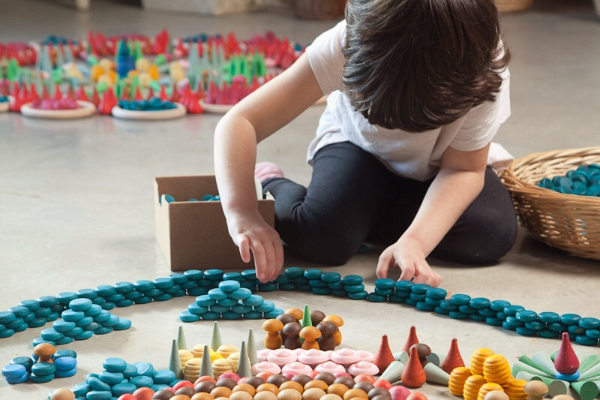If you’re like us and researching preschools, you have probably heard that play is the best way for kids to learn. But why is play so critical to learning? And how do we build the right play environment at home?
As part of our quest to answer this and learn more about intentional play spaces, we are interviewing folks across the world who have thoughtful perspectives. Here, we share the insights from our exchange with Casiana Monczar of Joguines Grapat—a Spanish artisan and maker of the beloved open-ended wooden Nins, Rings and more—discussing the critical role of freedom in play. Freedom enables kids to self direct, become self aware, and learn self efficacy, even at the youngest of ages.
Free play is a child’s self dialogue
What does free play teach? If you watch a child enter a play space, you will find her choosing from multiple play options. And, as as Monczar points out, if you watch closely enough, you will observe that she is really entering a dialogue with herself.
While she is literally asking herself, “What do I want to do? What do I like? What do I prefer? Where do I start?” what she is really asking herself through these questions is: “Who am I? What are my limits? Who do I choose as a traveling companion? Do I feel part of the group? What does it mean to share and give?”
This may seem ordinary and commonplace, but that mindset—allowing *her* to choose what she wants to play with—gives her the opportunity to learn more about herself, connect with her needs and interests and ultimately drive her own development.
3 Steps to Building Your Free-Play Space
How do we as adults and parents facilitate this free play? Monczar suggests starting with three simple steps:
- Place: Set aside a space that is theirs for play. This space will become one they recognize as their own turf—a space where they choose, they drive and they lead.
- Materials: Pick a few materials they can choose from that are safe and that you are comfortable with.
- Observe: Watch how your little one reacts to the freedom and materials you have granted. Is she interested? Can she manage them? With her leading and you observing, adapt the space (toy rotations, more or less materials) to her needs.
None of these three steps requires specific toys, lots of money or special training. What they do require is a mindset—to trust that our children can play freely in the space that we have safely constructed—and that this exploration, creativity and independence ultimately creates an environment where play is learning and learning is play.
—Casiana Monczar & Jordi Soler (Grapat); Hanna Chiou & Anne-Louise Nieto (Habbi Habbi)
About the Authors
Hanna and Anne-Louise are the co-founders of Habbi Habbi. They collect, post, and feature different inspiration about playrooms, product, and stories – for the modern parent. They launched an experiential playroom pop-up at the Stanford Shopping Center for the 2018 Holiday season and are currently working on launching their own product. You can learn more by following them on their Instagram @BeHabbi or visiting their website at habbihabbi.com.
Casiana Monczar and Jordi Soler are the makers of Grapat, a global phenomenon and a frequently sold-out brand in the world of open-ended wooden toys. The product started as their family project in Girona, Spain, inspired by their love of natural environments. Each piece of Grapat has a process of 17 steps before it is ready to put in a box and shipped. They love knowing that so many around the world appreciate their dedication to their craft. To learn more, follow them on their Instagram @Joguines_Grapat.
